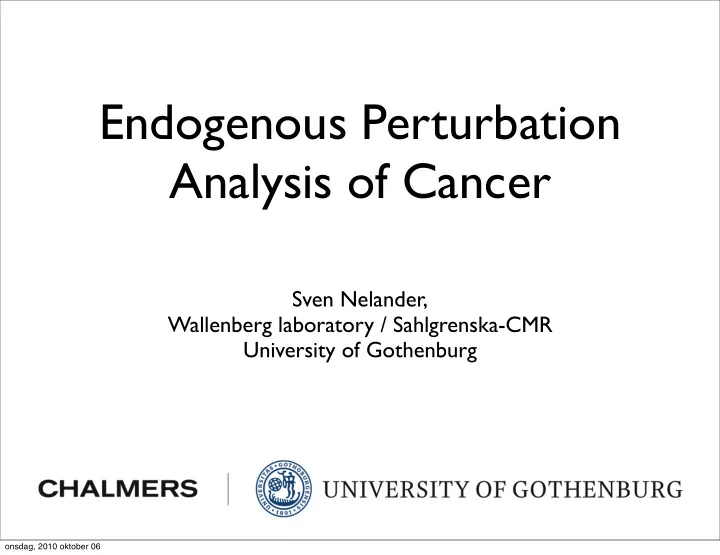

Endogenous Perturbation Analysis of Cancer Sven Nelander, Wallenberg laboratory / Sahlgrenska-CMR University of Gothenburg onsdag, 2010 oktober 06
Previous work at MSKCC: the CoPIA method Fraction of newly FDA-approved cancer drugs that target signalling Nelander et al, MSB 2008 onsdag, 2010 oktober 06
Comprehensive molecular profiling of primary cancer tumors and cancer cell lines 2. Arrays, 1. Tumor 3. Molecular sequencing samples profiles Genetic profile ~10s of mutations affecting protein seq DNA ~100s of copy-number altered genes Agilent Epigenetic profile Affymetrix Illumina ~100s of hypermethylated promoters Solexa etc.. RNA Transcriptional profile ~100s-1000s altered message RNA levels ~10s-100s altered micro-RNA levels (Representative numbers for glioblastoma shown) onsdag, 2010 oktober 06
Can we use perturbation models to ‘mine’ the cancer genome project data? onsdag, 2010 oktober 06
The cancer genome atlas project: data from 186 cases of glioma Genes Tumors Molecular profi DNA Contain 1: Copy Number 2: mRNA White: unchanged, Red: gain/upregulation, Blue: loss/downregulation Data generated and prepared by the Cancer Genome Atlas Consortium (MSKCC, Broad and other centers) onsdag, 2010 oktober 06
Relating copy number aberrations to mRNA levels is not so different from other ‘perturbation problems’ Perturbation-response pairs (e.g. siRNA → mRNA) Inherited genotype → phenotype pairs (e.g. CNV → mRNA) Acquired genotype → phenotype pairs (CNA → mRNA) onsdag, 2010 oktober 06
Intuitive model State space model Linear steady state equation onsdag, 2010 oktober 06
Linear matrix equations for n genes and p patients ‘System’ n x n n x p n x p n x p ‘Transfer’ n x p n x n n x p n x n n x n Solve for A or G using the Lasso penalty (Tibshirani 1995) and cyclic coordinate descent method (matlab/mex implemnentation, c.a. 30 sec for 10000 genes, 200 patients). For convex methods and gene methods, see e.g. early work by Yeung/Collins 2001, recent work by Boyd et al n x p onsdag, 2010 oktober 06
Relationship between A and G=-inv(A) System matrix A Transfer matrix G onsdag, 2010 oktober 06
EPoC net (G matrix) of glioma (identified in at least 200/1000 bootstrap runs on 10672 genes) GO analysis : GO:0007267 cell signaling (p=10-12), GO:0007399 nervous system development (p=10-10) What about the A matrix?: dominated by inflammatory genes and and blood cell markers onsdag, 2010 oktober 06
Main hubs onsdag, 2010 oktober 06
Does the glioma model contain any ‘drug targets’? amplified hub deleted hub 5 2 8 2 stimulated target suppressed target Numbers in boxes: # targets in each category onsdag, 2010 oktober 06
Test 1: is the network consistent between replicate datasets? onsdag, 2010 oktober 06
Test 2: does the network overlap with IntAct, NCI, HPRD, and Reactome ‘pathways’? onsdag, 2010 oktober 06
Test 3: does the network hold up to testing in glioma cell lines? onsdag, 2010 oktober 06
Can the geometry of G be used for survival predictions? CNA perturbations mRNA responses G projection of mRNA profiles onto the main axis of G gives a ‘signal amplification score’ Blue group: score<0, Red group: score >0 onsdag, 2010 oktober 06
Conclusion • The key idea is to reverse engineer human transcription using CNA perturbations and mRNA responses • Combination of two datatypes resulted in more consistent models, and a more relevant selection of genes (GO, inspection, survival) • Fast enough method that gives concrete, testable, predictions from cancer genome data. • We identified a new glioma tumor suppressor (p53-interacting protein NDN). • There are additional datatypes that were not yet exploited in our model. Several challenges remain. onsdag, 2010 oktober 06
Credits • Teresia Kling, Tobias Abenius (EPoC method) • Linnéa Schmidt, Linda Lindahl, Keiko Funa (experiments) • Rebecka Jörnsten, Torbjörn Nordling (theory) • The Cancer Genome Atlas Project and Chris Sander • Work was supported by: Vetenskapsrådet, Cancerfonden, Barncancerfonden, Assar Gabrielssons stiftelse, EMBO, Kungliga vetenskapsakademin, Sahlgrenska akademin onsdag, 2010 oktober 06
Recommend
More recommend